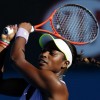By Randy Walker
@TennisPublisher
There is no doubt that the victory by Sloane Stephens over Serena Williams in the quarterfinals of the Australian Open was a landmark event in women’s tennis.
The 19-year-old became the first American player younger than Williams to beat her in professional tennis. The loss was only the second for the 15-time major champion in almost eight months, ending a 20-match win streak for the reigning Wimbledon, Olympic and US Open champion.
When Williams netted her final shot and Stephens raised her arms in victory on Rod Laver Arena, my first thoughts were to look back through the history of women’s tennis and look for comparable hallmark victories. The first one that came to mind was from 1970 when Margaret Court, fresh off clinching only the second Grand Slam in the history of women’s tennis, lost to a 15-year-old Chris Evert in the semifinals of the women’s event in Charlotte, N.C. While Serena is ranked No. 3, she has been as dominant of a force in the women’s game as Court was in 1970, regardless of ranking. People may argue that Williams was hampered by a back injury in the loss, but Stephens was able to triumph under extraordinary mental pressure on a grand stage.
Many tennis insiders tap Stephens as a future force in women’s tennis, some suggesting she will be a future world No. 1. Her engaging personality and charm make her a media and fan favorite and a marketers dream. The video of her immediately checking her mobile phone for text messages minutes after her hallmark victory was reminiscent of 17-year-old Maria Sharapova attempting to call her mother from a cell phone on court moments after winning Wimbledon in 2004.
This morning, I spoke with a sage tennis observer about the context of the Stephen’s victory and we agreed that the importance of the win will all depend on what Stephens does next. Will she move into a Hall of Fame career with multiple major tournament titles like Evert, Sharapova, Monica Seles and Jennifer Capriati? Or will she be regarded as player similar to Kathleen Horvath, Camille Benjamin or Melanie Oudin who had a big result at a major – all at the age of 17 – but could not sustain or improve their standing and hype and would become merely the answers to trivia questions.
Horvath was the only player to beat Martina Navratilova in 1983, taking her out in the fourth round of the French Open. Benjamin reached the semifinals of the French Open the next year in 1984. Oudin beat Sharapova en route to the quarterfinals of the US Open in 2009.
Of course, the Stephens’ win could catapult her into the upper echelon of women’s tennis, just as a 17-year-old Venus Williams did in reaching the 1997 US Open final, 17-year-old Sharapova did in winning Wimbledon in 2004 or Evert’s win over Court in Charlotte and her subsequent run to the semifinals of the US Open as a 16-year-old in 1971. Will that happen next for Stephens? Fasten your seat belt and stay tuned.

